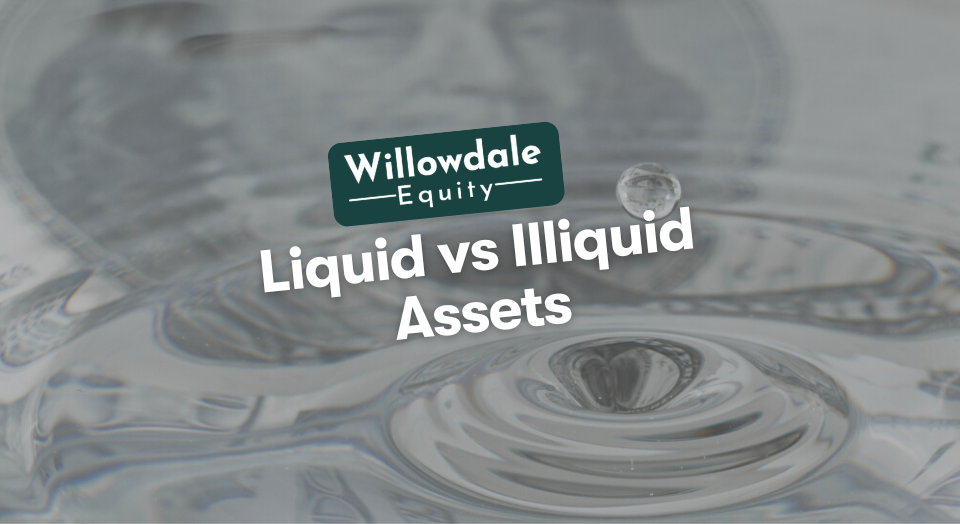
Liquid vs Illiquid Assets: Which is Better to Invest In?
This article is part of our passive investors guide on real estate syndications, available here.
With the way the markets have been since 2019, it is very easy to confuse what mix of liquid or illiquid investments will provide the greatest return for your investment dollars.
In this article, we’re going to explore liquid and illiquid assets and where the best place to invest is.
Key Takeaways
-
Having too much of your investments in liquid assets is penny-wise and dollar foolish.
-
Everyone’s investment goals are different. There is no out-of-the-box approach when it comes to investing. It would help if you looked at tax consequences, risk tolerance, and time factors, to name a few.
-
An illiquid asset has a longer curve, but the increases and decreases in value occur much more slowly relative to time. This gives the average investor the advantage, allowing them to make a qualified decision regarding what illiquid investments to invest in and for how long.
Liquid Assets vs Illiquid Assets
To understand which investment vehicle is best for your portfolio, you need a working explanation of the difference between liquid and illiquid investments. The difference between the two is that liquid investments are those assets that can quickly convert to cash.
They consist of physical cash, savings accounts, mutual funds, CDs, money market accounts, and bonds. Illiquid assets consist of real estate, including; primary residences, second residences, and investment properties. Also, rare art, manuscripts with historical significance, first-edition books, and physical gold and silver are included in this list. There are certain advantages of liquid investments that illiquid investments cannot provide.
Advantages of Liquid Investments
The advantages of a liquid asset are that they are typically low-risk and can easily be converted to cash with little or no penalties. What they provide to you is the ability to be prepared in an emergency and a cushion. It is recommended that we set aside at least six months of monthly bills for emergencies, like a fire or a medical emergency, should the primary or secondary earner become disabled.
The most common crisis is job loss. Having those monies available to be converted into cash and set aside will protect you from losing even more than just your job; it just may save your home. Another advantage is that if another investment opportunity comes along, you’ll be able to buy in without losing your position in other investments in your investment portfolio.
Accounts like a checking account, or mutual fund, are FDIC insured for up to $250,000, so losing them in the event of a bank failure, or if you experience financial hardship, your bank accounts will be safe. Finally, these investments strengthen your financial profile when applying for mortgages.
Most mortgage companies require at least three months of mortgage payments in reserve. This does not mean that you won’t experience pitfalls with liquid assets, so it would be prudent to outline some of the most common disadvantages of these assets. Sometimes a credit union can offer you different products unavailable at a regular commercial bank.
Disadvantages of Liquid Investments
Having too much of your investments in liquid assets is penny-wise and dollar foolish. On October 19, 1987, the stock market dropped 508 points, the most significant one-day drop in stock market history. That date is called Black Monday. Most of the holdings that investors had were in illiquid assets.
I know many people who had liquidated what was left in their portfolios. Still, had they been able to wait out the storm, they would have realized the market’s gains, which inevitably corrected itself over a longer horizon.
Unlike the crash in 1929, bank failures were uncommon because of the FDIC’s creation. Unfortunately, the illiquid investment market took a huge hit, and it took a very long time for it to heal itself. Liquidating these investments is, at times, a long process. So, if you have too many holdings in illiquid investments and need quick cash, be sure your portfolio is balanced.
Advantages of Illiquid Investments
The advantage of illiquid investments is that their relative values are typically higher than liquid investments. That is because there is a relationship between time and value. Typically the longer one holds an investment, the higher the market value. Cash or cash equivalents, like money market funds or a savings account held in a bank, are non-negotiable as to market price, and the value neither moves up nor down; if it does, it’s by a very tiny margin.
An illiquid asset has a longer curve, but the increases and decreases in value occur much more slowly relative to time. This gives the average investor the advantage, allowing them to make a qualified decision regarding what illiquid investments to invest in and for how long. The problem then becomes that of weight. How much weight and risk tolerance is an investor willing to take with his capital? The disadvantages of illiquid investments then present themselves.
Disadvantages of Illiquid Investments
The same advantages of illiquid investments over liquid investments could also be viewed as disadvantages. It is a matter of degree and viewpoint.
On the one hand, term investors want their portfolios for long-term growth, but the disadvantages become apparent for those looking for short-term gains and quick returns on investment. Illiquid investments are complicated to unload and cash out on because many partners could be involved in the transaction. Again, risk tolerance (the risk being am I losing access to capital and for how long, and whether or not I will receive a liquidity premium for this lack of access?) is another consideration for this investment.
Liquid vs Illiquid stocks

There are both liquid and illiquid stocks in the marketplace. The difference between them is measured by how easily stocks can be bought and sold. The difficulty is in finding prospective buyers for a stock.
One of the best ways to tell whether or not a stock is worth the price is whether the risk of investing is worth the price. Stocks that rise at an incredible rate should be viewed with some degree of caution because how quickly they can increase is also an indicator of how quickly they can fall.
If you do not have enough capital in reserve, your portfolio could very well be at risk to some degree, depending on how and who operates it. For most investors, liquidity is not a concern because they did not purchase the stocks for the short term; cash gains in the first place.
On the other hand, liquidity is a concern for traders. Financial advisors recommend looking at stocks with their eye on four and five percent returns because the holding period is very short. Liquid stocks are best defined as large companies’ stocks with a maximum interest from big institutional investors. The way to decide on which types of investment goals is as individual as a fingerprint.
It All Depends on Your Investing Goals
Everyone’s investment goals are different. There is no out-of-the-box approach when it comes to investing. It would help if you looked at tax consequences, risk tolerance, and time factors, to name a few. Many investments have caveats that withdrawing the investment before maturity could trigger tax implications or be required to pay a fee to the portfolio manager.
Suppose you are a landlord and you unload the property. In that case, there are protections in place for your tenants from being prematurely evicted from the property. In some jurisdictions, you could be sued for violating local, township, county, or state law regarding tenants and their rights under the law.
Frequently Asked Questions About Liquid vs Illiquid Assets
Illiquid assets include real estate, rare art, manuscripts, first edition books, real gold or silver, and any item that needs more time to liquidate than a cash equivalent or physical cash.
An illiquid stock is any stock where the institutional investors show little to no interest in the stock due to low performance. Low performance is demonstrated by low trading volume, lower values daily, and the difference between the bid price and the asking price.
Liquid Assets vs Illiquid Assets - Conclusion
In this article, liquid and illiquid assets have been looked at from the perspective of the investor or investors. To have a healthy financial future, you must look at your age, financial status, and anything that can affect your future planning regarding your unique wants and needs.
If you’re interested in building long-term wealth through private equity illiquid tax-advantaged multifamily real estate across the southeastern United States, join the investor club here at Willowdale Equity today.
Sources:
- The Nest, “What are the Benefits of Having Liquid Assets“
- FDIC.GOV, “Liquidity and Funds Management“
Interested In Learning More About PASSIVE Real Estate Investing In Multifamily Properties?
Get Access to the FREE 5 Day PASSIVE Real Estate Investing Crash Course.
In this video crash course, you’ll learn everything you need to know from A to Z
about passive investing in multifamily real estate.
We’ll cover topics like earned income vs passive income, the tax advantages, why multifamily, inflation, how syndications work, and much much more!




